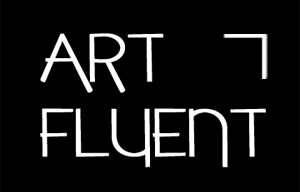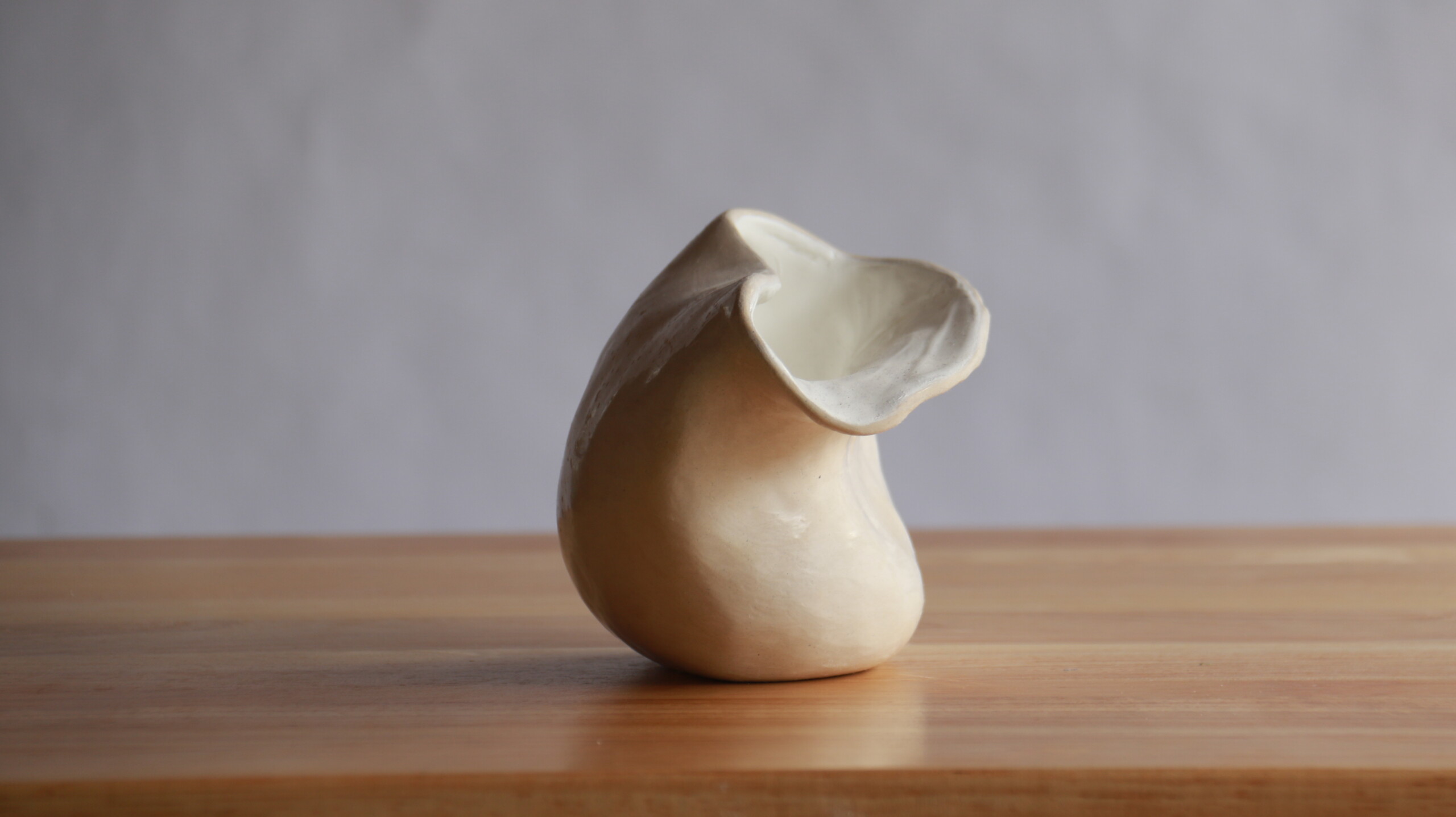
five, finished unfired, paperclay
-Koren, we'd love to hear your story and how you got to where you are today, both personally and as an artist.
I’m lucky enough to have known from a very young age that I wanted to be a creator, a maker of some kind. I’m unlucky enough to have been too scared to pursue it until about 8 years ago. I grew up (1 of 6 children, 1 boy and 5 girls) around creativity and making; my mom had a great sewing room full of stuff to sew and crochet with and we saw her cross-stitching and crocheting, making stuff, all of our lives – she taught us how to do those things and shared the joy that comes with creating. We loved sitting up making stuff late into the night. My dad had and has an amazing carpentry workshop that we were allowed to play with him in; we got pretty comfortable around tools of all kinds and saw how fun and cool it could be to make your own stuff. We were steeped in these ideas and saw the value of having your own space and time to create. For some reason though I didn’t really believe until recently that I could commit to a creative path.
My first love was writing from a really early age, next was drawing and photography but I was really struck with some knowing “what I’m here for” when in high school our photography teacher was out sick and had the keys to the paper cabinet so we couldn’t print, so we got to try sculpting in plaster with the art class next door. As soon as I started carving it was like I was filled with a vibration and knowledge that was all me and right and true and I remember thinking “this is what I’m supposed to do!” --- and I did for a little bit at home in my bedroom. But for whatever reason and for so many years I went a bit sideways or some such and pursued more “lucrative” or “typical” careers. Though I guess still sort of not SO typical.
I went to film school to study screenwriting – that was exciting to me; seemed a cool thing to do with my writing, but I quickly got deterred by really not enjoying the form. I immediately pivoted to cinematography as it was interesting to me given my previous like of photography – I found I loved the movement of cinematography. I decided why not use film school to learn the tech skills of cinematography and I’d work on my writing at home outside of school (which I never really did back then). I fell into a film career for 16 years, though never really digging into cinematography (I worked as a grip). I think I realized sort of early on that I didn’t want that; I think I could tell it would be the wrong path for me, that I’d really have to commit to doing it and it just didn’t feel like what I wanted even though I’d loved doing it when I did. It’s like I felt like I was performing. While working in film I took a sort of accidental break from college between junior and senior year because I was getting regular film work and making great money, especially for a 22-year old. After about 13 years I really felt the loss of the schooling, at least that’s how it felt - like I didn’t know anything but my way around a set; I’d been in a film bubble. Around 2010 I met a great fella (who’s still my sweetie) and between my feeling like I’d really let myself get behind in life and great conversations about what we wanted in life and such – I decided to go back to school and finish my undergraduate degree – which was pretty great because I wasn’t interested in film anymore and all I had left was electives; it couldn’t have been a better time to go back.
I always remembered my love of writing and sculpting, that feeling that came to me that really felt like me when I thought back to when I’d done those things – I wished I could get back to that – to really honor that, be that. I was always glad I had those times and that I’d kept some of what I’d made back then to reference. So, somewhere around that same time I’d found a community ceramics class for wheel throwing – I was really drawn to the physicality of wheel throwing then. I found this class and did a session or two (like 4 or 6 weeks each) and just loved it. I tapped back into myself, and it felt great. So that in addition to going back to school really helped me to see a way out of film and to reconnecting to myself. I took leave from film work and did full time school for 2 semesters and finished. While there I took a couple of linguistics classes, which had always been interesting to me for a lot of reasons; that we humans speak thousands of different languages is bonkers to me, and how we use our languages to communicate at all and the problems we can have was something I wanted to dig into. And, it was a path I thought I could see a future in, something that not only seemed really fun, but also linear or something and I guess I needed that in order for me to feel like I could do something and soon to get out of working in film. It truly was invigorating and rewarding; I loved doing the research and having ideas and putting them out there in my writing and projects. So, I went to graduate school for linguistics – even though I already knew the answer to the lottery question – I would be a writer and a ceramist. I’d even said it out loud. But going to graduate school still made sense to me, so I did and I had a blast, and I left the film business in 2013 and have not been back.
After graduate school my partner and I moved to Los Angeles, CA (where he’s from and where I’d heard it was 73 and sunny most of the time and that there was an ocean – all things that appealed to this girl from the Midwest who’d always wanted to leave the Midwest for the west). As I looked for work as a linguist, I felt the call to make art more than I had in a very long time. I’d ignored it for long enough and it was hollering at me loudly from the inside to make stuff. My job as a grip had been pretty physical, I was using both of my arms and hands all the time and muscles and building and rigging stuff, so I think that might have helped in tiding over that “making stuff” part of me in a way. After some years of researching and writing it was like that part of me that was a maker was asking “what about me!?” It was then that I really started digging into those feelings I’d had before, those feelings that felt like the real me, especially that first time I sculpted. I wanted that and to finally stop ignoring that desire. My partner and I agreed that I could turn the little model-t garage in the back into my studio. I decided to start where it had really come to me the most and I pulled out all of my art supplies that I’d never gotten rid of, some clay working tools and some carving tools and I went and bought a bag of plaster, a chisel and a mallet – I made a couple of plaster blocks, and I started sculpting. I woke myself up! I have been creating regularly since then. I was 40 then, I’m 48 now. I’d let so many years go without it because I didn’t think I had the time or something and I felt lost because of that and always choosing other things. I committed then that I would never let myself let this slip away again – I was going to really start saying “yes” to me.
I did get a job as a linguist, doing discourse analysis, and though it was fun and rewarding and I was working in the field I’d studied! – it was all face in a screen analysis, and I came to find I didn’t really like that and then the company folded and that was sort of that. All at the same time I realized I wasn’t quite sure I wanted to pursue that same tack in linguistics. I’d loved teaching in graduate school, so I started looking into teaching and found a company that does reading remediation – I liked their methodology; it matched up with a lot of what I thought was deeply interesting in psycholinguistics in general and language processing specifically, and it seemed pretty cool to put that knowledge into action to help people read to their potential. I’ve been doing that since late 2018.
All the while I’ve kept that commitment to myself, and I’ve had regular conceptual practice and a practice of play! I don’t wish for it anymore, I do it and that has absolutely changed my life to have said “yes” to me, finally.
This clay series came as a result of a series of decisions I’d made to not allow barriers to stop me anymore. I’d been having fun carving into the plaster, but I felt the call back to clay. I didn’t have the money for classes or a kiln, but I knew I wanted to work with clay, so I decided to go get some and try a bit of hand building. It was funny how I just hadn’t been drawn to hand building and sort of wasn’t really then either, but knew I wanted to play with clay, so I was going to give it a shot. I went to an art store down the street and came across paper clay, ceramic paper clay that Laguna makes, and asked about it. The shop fella told me teachers use it a lot when teaching children how to model with clay and it’s stronger and easier to work with because of the paper fiber inside and that when it air dries it’s still sort of strong. That sounded good to me since I was going to be hand building and sculpting and knew I wasn’t going to be firing the work anytime soon. I’d also heard about and found the classic book “Finding One’s Way with Clay; pinched pottery and the color of clay” by Paulus Berensohn at the library and LOVED it – so I bought it, wrote up and taped to my workshop wall his explanation and expectation of the first exercise and I believe that is what got me on this track and really loving and honoring hand building. The explanation of the exercise, essentially building a little pinch pot, tells you to remember it is just an exercise. Let go of expectations and be present. Start by sitting and holding the ball of clay with your eyes shut, feel it, be with it, then start forming when it feels right – and then instruction on how to do that. I did that. I was in, 100%. And that changed the way I make. I am more open, receptive, and don’t put a bunch of expectations on what I’m doing.
That is absolutely where this whole series started from. My first vessel that wasn’t as symmetrical as I’d wanted was a practice in letting go of expectations and saying to myself, “what about no expectations, what about the exercise of just going with it?” It was a challenge at first but also it made sense to me for some other reasons. I realized what if instead of scrapping the piece when it’s not “right,” I stay with it and see what shape comes and with that there will be less waste, and less time spent cleaning up waste and reclaiming and such. What if all of this leads to a more efficient, or something, process? I found myself so curious about what would come so I went with it; I really felt I was onto something.
Things just sort of felt like they were aligning. It was exciting, like I was learning something about myself and letting these vessels emerge into the world. They were just coming out. I started to notice ideas would just come to me like “push that side in a little” or “slap it around a little and see what shape comes and feels right” or or or – I decided to follow those instincts, if that’s what they are/were, and that was fun. Anytime I questioned going along with the idea it felt like I was going against myself and that felt wrong, so it kept feeling “right” energetically to go with what came. And in the same way that ideas came, so did knowing when a piece was “done” – I put that in those quotes because they are sort of never done, but done for now, in this iteration or time, I guess. Through all of that I realized, because I had a lot of reps now, a regular practice, not just the pieces, was what it was all about and it was a joy – and I realized that I’d done it, I’d gotten what I’d wanted, I just never could have really articulated it – I was doing it, Iwas an artist even if I wasn’t ready to accept the label.
I didn’t know in those early stages that I wasn’t going to fire those pieces (or any since then). When I started this I figured I would connect with someone with a kiln at some point and fire them – I knew it was ok for them to be bone dry here for a while. But at some point, in making them it occurred to me that maybe I wouldn’t fire them ever. Maybe they aren’t functional in that way. I loved how they looked, their color and texture and I wondered how I could preserve that. It occurred to me, what if I don’t fire them because that process is dirty, and it’s a lot more steps and isn’t it nice to have fewer steps and fewer bits and pieces ? I was having this wonderful conversation with myself and the work and the universe. It was great. I started to look into ways to protect the clay without firing it, and learned about cold finishes – tried varnish and hated it! Felt it sealed it off in a way that killed the piece’s energy (sorry sweet vessel!) and that’s what brought me to not glazing and not firing. And since I was using paper clay, I realized, even better as I’d already realized it was stronger as it dried than other ceramic clay I’d worked with; it wasn’t brittle, and it was easy to handle. I realized I wanted them to stay alive is how it felt to me. I came to burnishing and that’s what I started doing, which was also nice because it strengthened the clay a bit more and gave it a sort of smoothness that I liked.
That’s how those all pretty much came to be; that process kept feeling right or I would have changed it – that’s my practice, to listen and make moves according to my instincts. That’s pretty much how I come to make all my work – I wake up and the work I’ll work on comes to mind. It hasn’t been clay for a bit, it’s been block printing and writing haiku, but I can sort of see clay down the path, walking up and catching up and it feels like it’s going to be time for it again in a little bit. But while I was making this series, and it was years, it was just the clay would come to mind (I use 2 different paper clays, one is light, one is dark, one from paper one from wood pulp respectively) and I’d grab the block and pull off how much came to mind, a hand full or cut off a chunk. That’s what I mean by unplanned save for what I’m making with. But I’ll say even that is sort of unplanned. If I’d woken up today sort of expecting to keep on going with block printing and clay was on my mind front and center, I would have made with clay today. So, there’s that. But anyway – for this series clay was always the thing. I’d stand at my workbench and just start by holding that clay just like the Paulus Berenshon exercise instructs and whatever came to mind I did; be it start pinching, make a slab or coils, what-have-you. That process, that saying “yes” to that process really taught me a lot about myself. It brought me to accepting myself by accepting the work.
A big part of the conversation I was having while I was making this work was, was it even anything? Was it ceramic anymore? Probably not. Was I ok with that? I came to be. Was it something anybody would want? Turns out, yes, but that had to not matter. Did I even like it – I did. I loved its energy; I couldn’t believe what was coming out of me. But, as I said before, even if I didn’t like it, aesthetically, I loved the process and all I’d gotten from the process. I did not think of myself as an artist then. I struggled with the “label” – who was I to say I was an artist? It was with this body of work that I found a true acceptance of myself as a person and as an artist. I love the work and I love myself and that happened together. I realized that these are pieces in and of themselves and they are full energetic representations of me and the universe through me in those moments and that is enough and pretty cool, and what art is. That was when I came to a definition of artist for me: an artist is someone that is purposefully putting out a representation of their self-expression – letting all that energy that is inside out on purpose. That felt so right to me that I came to fully accept my work and myself. It was an amazing revelation to me! That was it for me – I’d reached the next phase of being for myself after many years of wishing I would even try.
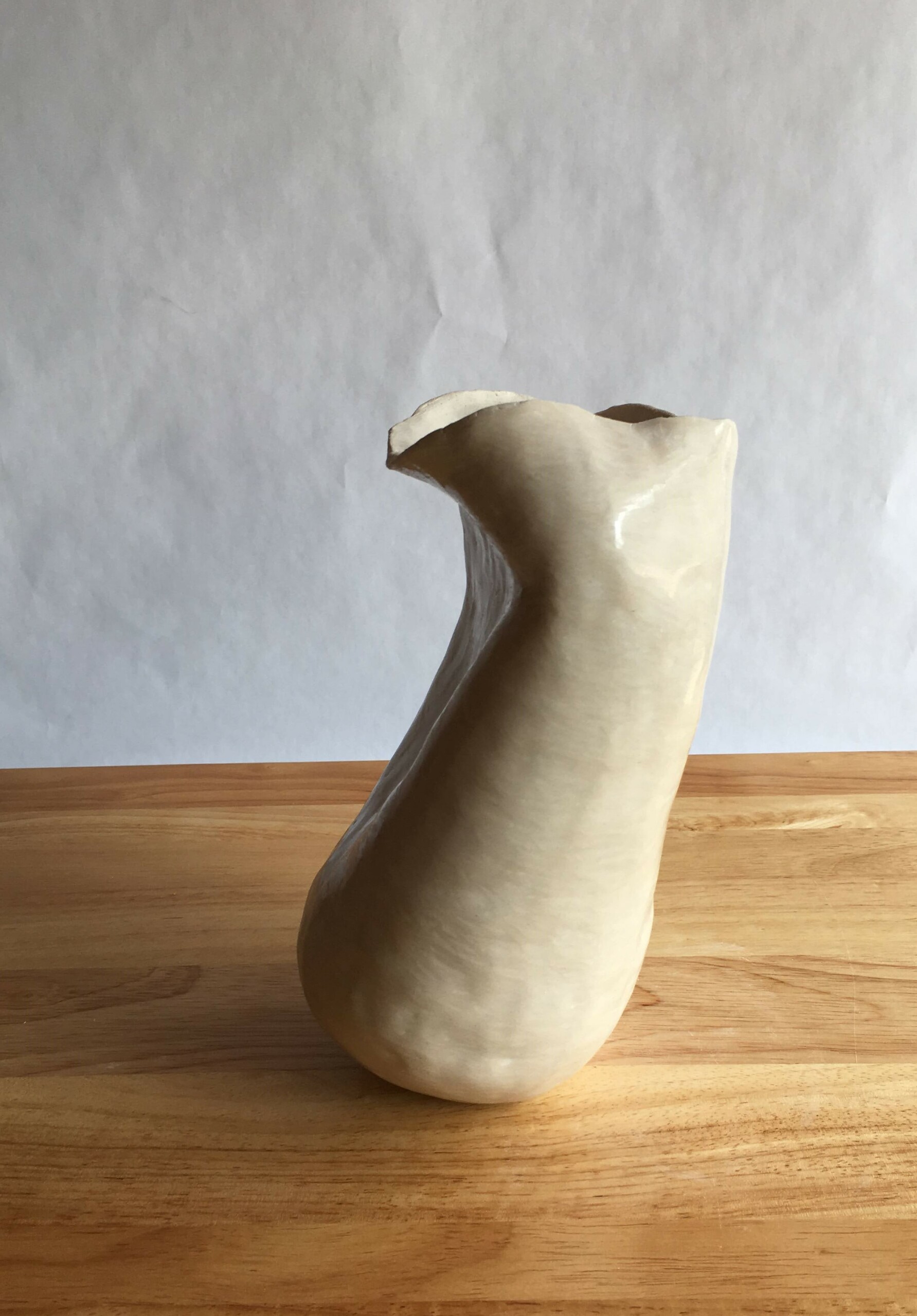
twentyfour, finished unfired, paperclay
-Your decision to leave the work unfired opens the possibility for change over time or a return to the earth. Can you elaborate on why you chose this approach and how it relates to your artistic vision?
It just came to me sort of piece by piece, as I was describing before, and kept feeling right – I liked needing fewer things; fewer barriers or obstacles to entry and end as it were. And I really liked how the work looked and felt not just tactically but energetically. But I’ll add, I kept (and keep) checking myself to make sure this is what feels right for the work. I also think it sort of came easy to me to accept the idea of finishing unfired, actually downright excited by it, because I liked the idea of less electricity and fewer chemicals, and ease of reclaiming if I wanted to, or whomever didn’t want the work anymore – so it all was just lining up and feeling right.
Similarly, to how I came to hand building, partially out of necessity, then came to adore it; all the bits of the practice made sense to me. When I decided to really investigate finishing unfired – once those ideas landed and felt right to me and I did some research it all just kept making sense and I kept being excited by it. That’s pretty much how I do everything; listening to myself, following my instincts, especially when I get an idea that feels uncomfortable – I want to see what comes, I want to see if I’ll be surprised and essentially rewarded by taking what feels like a risk. I’ve spent a lot of years not doing – letting myself be scared and sort of hiding, so this has all been a bit of a practice of challenging myself to not hide anymore. It’s really been something – the vulnerability we feel when we’re creating, it’s pretty awesome to not run from it anymore, though I am certainly challenged by it; it’s not easy, but it’s fun.
When it comes to the fact that the work can be changed over time or reclaimed and such because it’s not fired – I came to really like that because it went along with letting the pieces just become what they would become. So, when I learned more about cold finishes and liked the burnishing with and without oil I also wondered, what will happen to them in time – what about if people touch them a lot, which I’d like, will their colors change? I immediately liked that idea; it felt like it lined right up with letting the pieces just be, whatever happens happens. I really like that it allows whoever interacts with the work to be a part of the work and not just an observer or “owner.”
I don’t want any of my work to be locked away and untouched. I often think that when I have a show, I’ll want people to touch the work and let it change as it will. I want people to interact with it. I want people to touch it and look closely at it. and if they want to fill it with water that will be a conversation they have with it and themselves and so it goes. That hasn’t happened yet. But if it does, I hope the person(s) will tell me what that conversation was like and how they feel about it now. And I’ll share how I feel too!

six, finished unfired, paperclay
-Your work is described as unplanned. How do you approach a new piece or project without a specific plan, and what role does experimentation play in your creative process?
I’m a multi-disciplinary artist because of the (semi) unplanned nature of my work. I don’t pick a medium and focus (though I sort of did back when I started this series), I can’t – because I don’t want to, because I love that for me my expression wants out in many ways and that is part of why the “unplanned” save for what I’m creating with this or that day.
When I made most of this series (which is sort of on-going though taking an unplanned pause because working in clay isn’t calling to me right now) I did want to focus on clay and I knew I would be hand building because I didn’t have a wheel – that was the extent of the plan and once I started forming even the first vessel I started honoring that voice inside of me that was saying things like “how about don’t scrap it because it’s uneven? how about see where it goes if you just keep going?” That felt scary and like an experiment right away and like an invitation to a great conversation and to outcomes I had never thought of – and that was so exciting. I remember thinking, “ok, yeah, that’s good too because less scrap so taking up less space with the cast-off stuff, and sort of an interesting way to let myself be led by whatever happens.” I was careful to recognize that I wasn’t going with that choice just so I didn’t have too much for scraps. It was clear to me that if I kept going with a piece to see what happened with, I would be challenging myself to keep saying “yes” to that voice and not fighting that instinct. I was so interested to see what it felt like to not fight myself because I had for most of my life. So, just staying this course feels like an experiment and the little ideas that I don’t expect that I say “yes” to daily are experiments and I go with them. I get scared sometimes because I think the idea is something that could ruin the piece, but I do it anyway because that’s what I’ve committed to, saying “yes.” And when I don’t like the way, something comes out, I just observe how that feels and what I learned from it and usually what I learned is that I wouldn’t have known I don’t like this or that in my own work, or in this specific piece if I hadn’t tried it and that’s good information for me. It also helps me know that I am being discerning and not just going “yeah!!!” to everything that comes out of me – but maybe that would be ok too.
This whole series and this way of working has helped me hear my voice. I’m quicker than I used to be at knowing if something feels true or not – which I guess is its own question – what do I mean by that? All I can say is if a piece feels like it’s got a good vibration then that feels true to me.
So ideas occur to me and I experiment with them, I try them out a little or a lot and I see what I can do with them, do I like this or that? Do I have the time for it right now, like frame making, or watercolor botanicals – they appeal to me but they’re not a focus right now. Sometimes I think a good experiment for me would be to really plan something!
Right now, block printing is a huge focus to me. Patterns and repeats by hand for the most part, though some digital. That work, for me, is more planned than my clay work, but I still let instinct run things a lot. I know I’ll do more clay. I feel it in there and I know I want it and miss that feeling of that sort of creation. But I do the same process, essentially with all I do. Like these post cards I’m working on right now- planned in that I’m doing post cards, and this specific block repeat and with ink and paint, but which colors where and when is unplanned. I sit down and trust what comes. I just see this or that color red in my mind and where it’s going to go, and I do it. And sometimes I’m a little worried or uncomfortable that I’m not going to like it – I want to like it, apparently – but I know that I love this process and it feels so true to me and that’s more important. And! what I’ve really come to know, and trust is that all these little moves, physically, artistically, psychologically, and physiologically, they all add up and they’ve already added up to a life I’m loving so I’m going to stay with it for now.
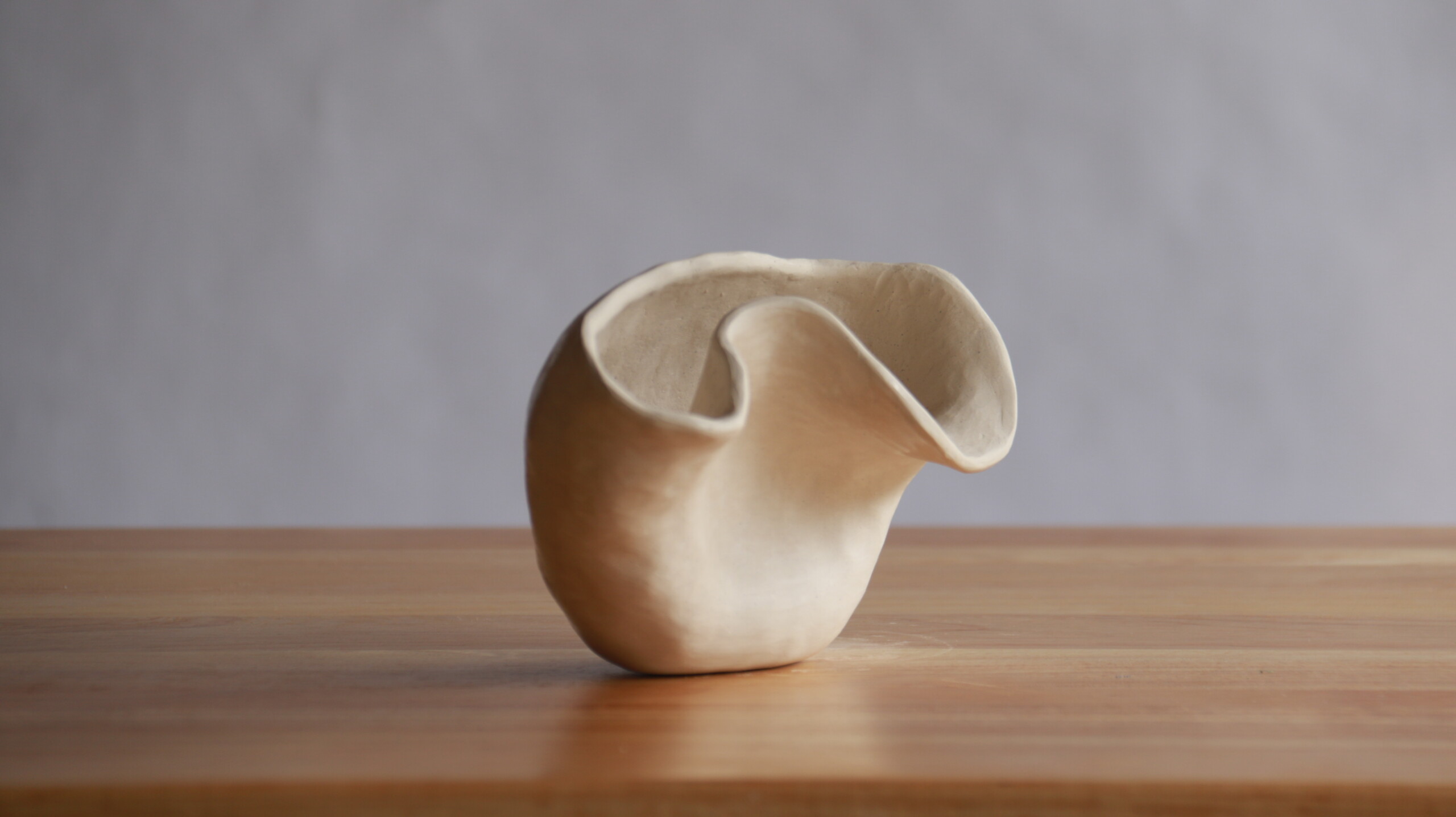
four, finished unfired, paperclay
-You mentioned that your pieces are representations of imperfect beings. How do you define perfection in the context of your art and philosophy?
At first, I was like, hmmm – busted – imperfect and perfect what was I talking about!? ha-ha. But I know – I’ll highlight that I do say “imperfect” beings in scare quotes to highlight the idea of imperfect/perfect and that there is this sort of idea that perfect in ceramics is symmetrical, flat bottomed, expected almost, can be used in a way that is expected, not questions to ask, or some such. Truly, perfect to me is anything and everything. It’s real and not real. It’s a dangerous word. A long time ago I came to sort of decide that perfect is not real except for in systems and cause and effect and the like, like if you don’t eat, you’ll be hungry, perfect, that’s how that works, clean. But perfect is not real in subjective things like “that’s a perfect pot and that’s not” – too much depends. So, in that I sort of flip it and in my mind, everything is perfect because it is and that’s that. So, when I speak of “representations of ‘imperfect’ beings” I mean anything or anybody that someone judges as not quite right – these works are representations of those sorts of things and beings. I say, “yes they are”, they are perfect because they are. The pieces and I are representations of something and someone that some have had issues with, don’t like, think are wrong in someway and we’re here to say “we are here and we are beings and we are allowed.”
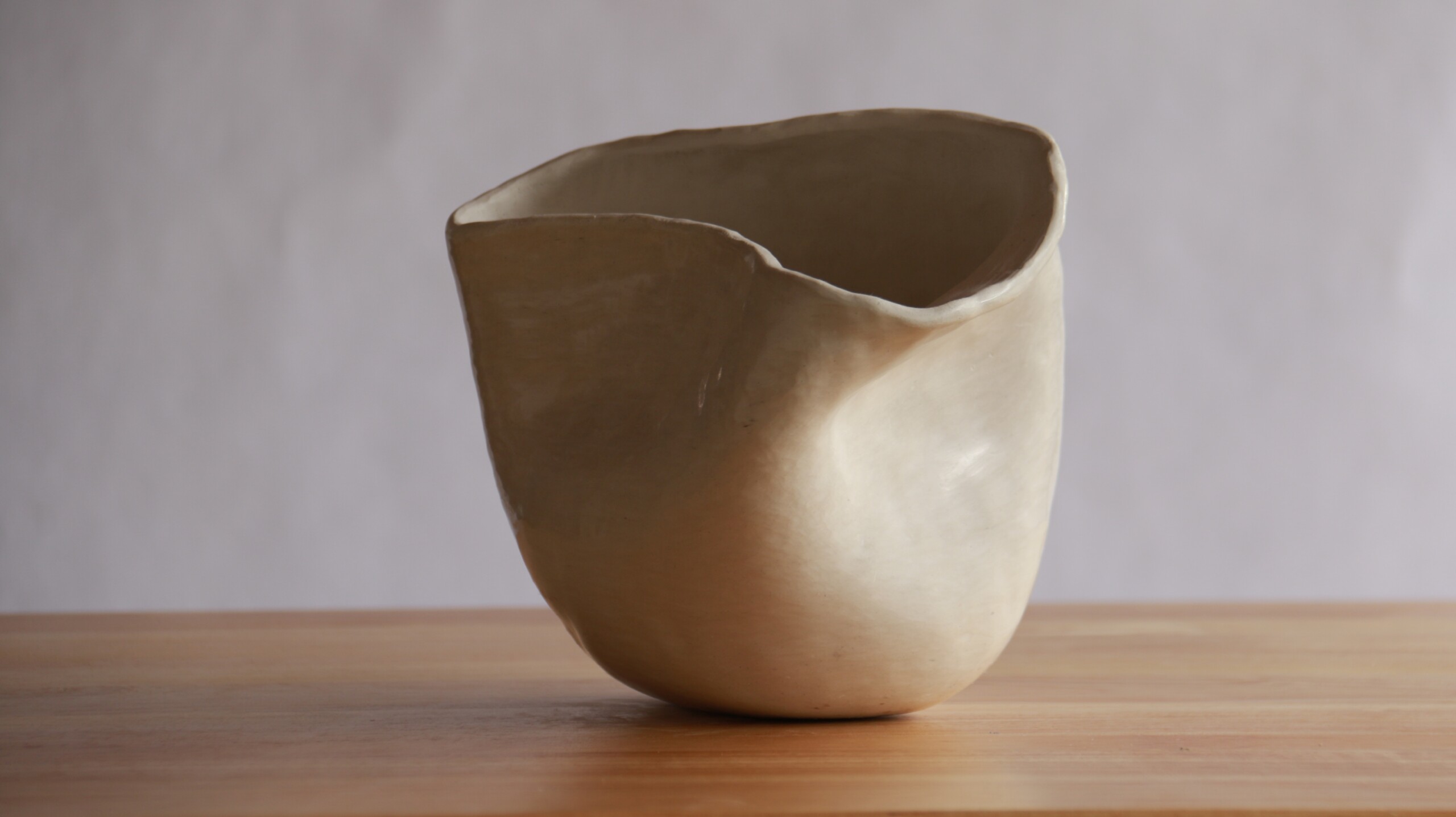
eight, finished unfired, paperclay
-What’s the best way for someone to check out your work and provide support?
Thanks for asking and sharing: My website korysalajka.com has all of my work, blog, contact page, and link to my page where I share my haiku. My work can be purchased through my website, and you can contact me though my website or Instagram if you have any questions. I’m also easily found on Instagram using my name: @korysalajka, and I have a spoonflower shop where I’m building some wallpaper and fabric collections under the shop name kory_workshop_shop : kory_workshop_shop's shop on Spoonflower: fabric, wallpaper and home decor. I’ve also been writing haiku daily since April of this year and it’s been a wonderful addition to my creative practice. Reading my haiku the Vocal Media website (you don’t have to be a member to go on their website and read) kory salajka | Vocal is a small way to provide support as every read gives me a small amount of money which is sweet.
This was fun! Thank you for these questions – it was such a delight going back there in my mind and remembering how important starting this body of work was and how it’s been over the years and still is for me, such an important part of my life and still such a joy to create this way. I would hope anybody, if there is even a tickly desire for anything will honor it, even if just for a minute a day. Anything really IS something. I wish I’d really known that a long time ago.
Statement
This series is a direct expression of my energy and being, an exercise in intuitive creation; unplanned save for that creating was actively happening with clay, the rest was a practice of listening to myself, to the voice within that says, “one more coil,” or “push it over” or “put a hole in it” or or or. My work is an exercise and example of what I wish everybody could and would do – just show up, just give yourself a chance, even if for a few minutes, even when you have no idea what you are trying to “say” and let the creative energy out of your body; let yourself be. I am convinced this is where we find ourselves and learn to share our true selves with the world as I know it has helped me.
These pieces are therefore representations of “imperfect” beings. Beings that have been accepted and “allowed” to continue to be; let to exist rather than collapsed and reclaimed because not symmetrical like so many expect of clay works. These pieces continued to be created until it just felt right to stop, at least for the time. They are finished unfired and burnished, sometimes with oil to give a little sheen, but sometimes no oil for the dryer finish. Finishing the work unfired was a decision that came during my conversation and growth with the work early on. It became clear that these would be pieces that could change over time or be returned to the earth if that is what comes to be.
My work stands for saying “yes” to myself – to ourselves - “yes” to accepting ourselves and others for whom, what, and how we are, as we are. These pieces are an example of the beauty and great energy that comes from acceptance.
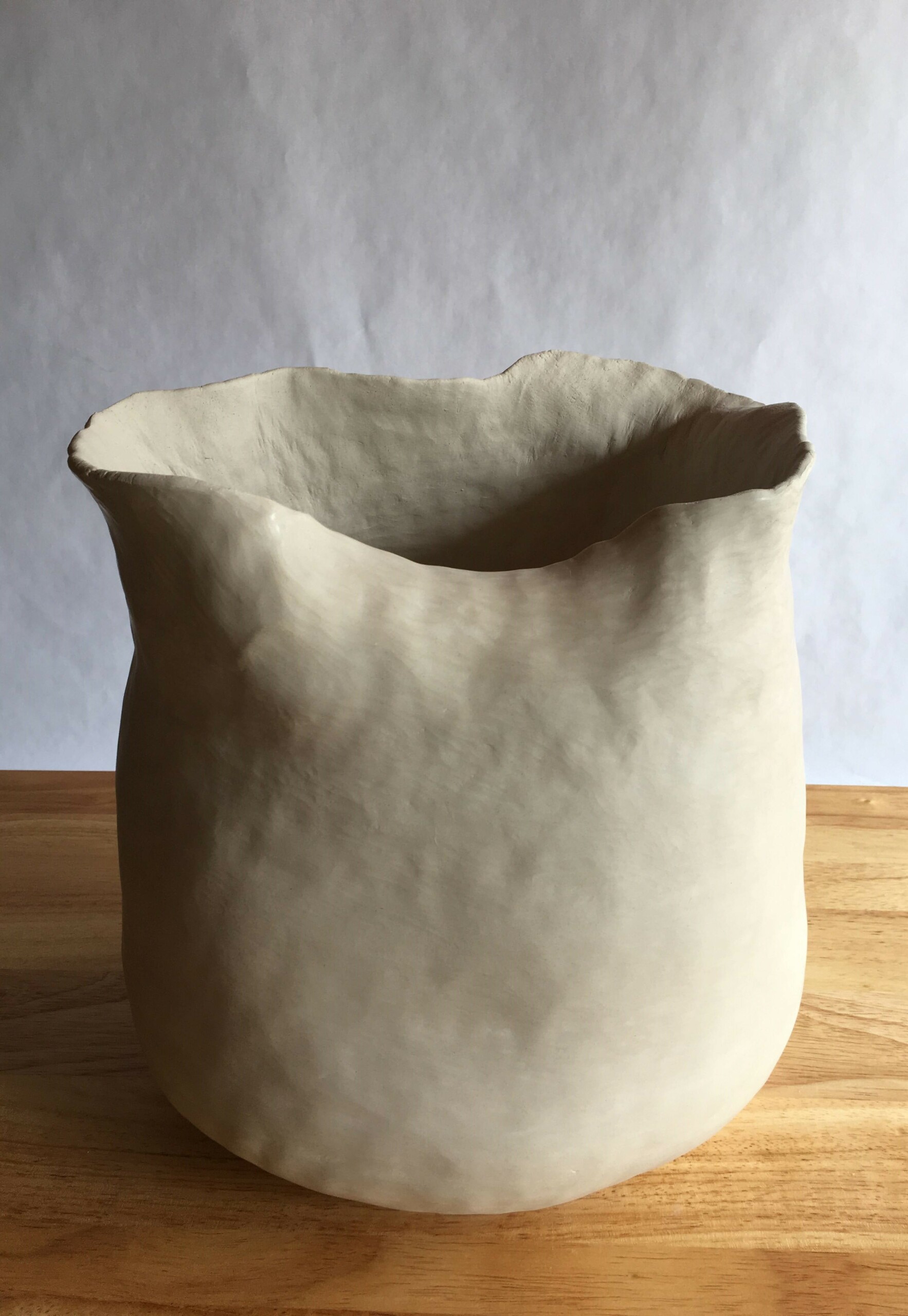
twentyeight, finished unfired, paperclay
Bio
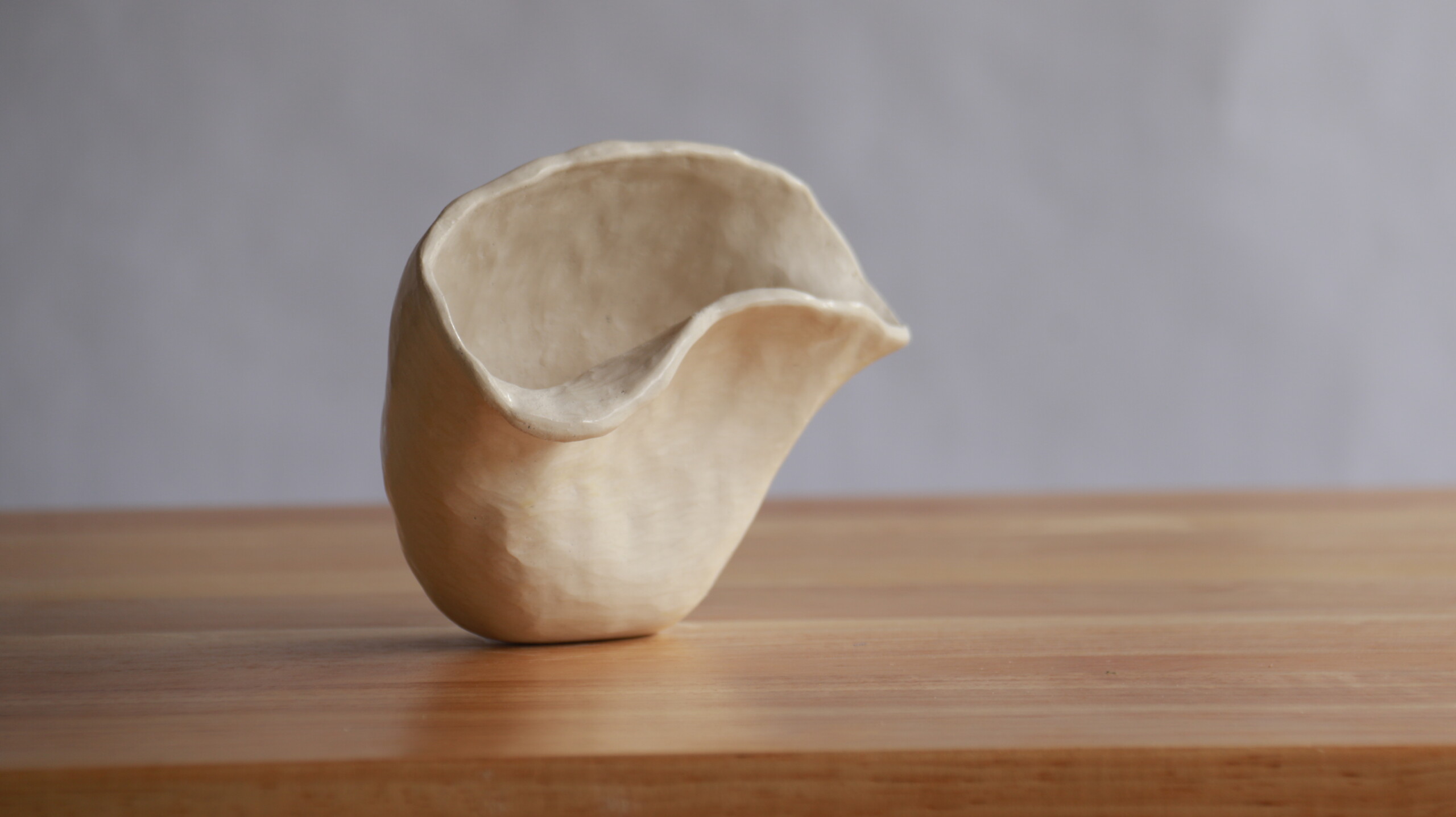
seven, finished unfired, paperclay
Kory was born in Palatine, Illinois, a suburb of Chicago, in 1975. As soon as she was aware of winter and oceans, she knew she wanted to live in warmer climes near one of those oceans, and in 2015 relocated to Los Angeles, CA, where she now lives and works. After many years working in film, yoga, and linguistics, she finally committed to herself and to making art, and now primarily works in clay, and block-printing, though other forms of expression make their ways into her practice as well.
Kory’s work is a representation of herself and human beings in general; the energy that flows out of us when we are true to ourselves and sharing our energy with the world. Often asymmetrical and off-kilter, her work is meant to not only share the energy of being and movement, but also to raise questions about expectations, completion, definitions themselves, perfection, and acceptance as her work asks to be accepted as it is, in the moment, much like people do.
